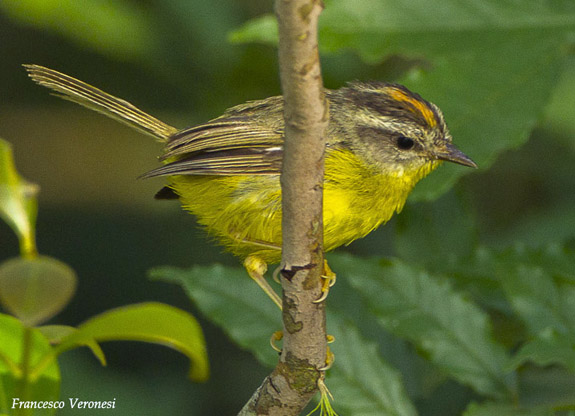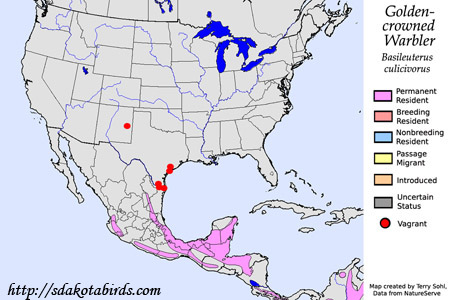| Length: 5 inches | Wingspan: 7 inches | Seasonality: Non-resident in South Dakota |
| ID Keys: Gray crown with black-bordered orangish crown stripe, greenish gray upperparts, yellow underparts. Both sexes similar. | ||
 The
Golden-crowned Warbler is a widespread species of warmer locations in both
North and South America, extending from Mexico and Central America southward
through Brazil. In the United States they are a vagrant, with a number
of sightings in far southern Texas, and one in eastern New Mexico.
There are a number of sub-species present throughout their range, with the
possibility that birds currently classed as Golden-crowned Warblers may
indeed comprise multiple individual species.
The
Golden-crowned Warbler is a widespread species of warmer locations in both
North and South America, extending from Mexico and Central America southward
through Brazil. In the United States they are a vagrant, with a number
of sightings in far southern Texas, and one in eastern New Mexico.
There are a number of sub-species present throughout their range, with the
possibility that birds currently classed as Golden-crowned Warblers may
indeed comprise multiple individual species.
Habitat: Found in humid, tropical and sub-tropical forests, including mature forest, second-growth forest, and sometimes heavily managed lands such as coffee plantations or other tree plantations. They can also sometimes be found in thickets and undergrowth of more open woodlands, or in brush with nearby forest land.
Diet: Feeds mostly on insects, but they will also take fruits, berries, and seeds on occasion.
Behavior: Very active foragers, Golden-crowned Warblers typically occurs in the forest understory. They are somewhat gregarious, often forming small loose foraging groups that may include other small insectivorous species.
Nesting: The nest of a Golden-crowned Warbler is a dome-shaped structure built on the ground, typically in a location that is semi-protected by a clump of vegetation, a stump, or other protective cover. The nest is built of grasses, roots, and other fibrous plant material. The female lays between 2 and 4 eggs, which she alone incubates. The eggs hatch after about 12 days.
Song: The song of a Golden-crowned Warbler is a series of rich warbling, with variation between different populations within their broad range. They also have a sharp tik note and a scolding chatter.
Migration: Golden-crowned Warblers are considered permanent residents throughout their normal range.
Feeders: Will occasionally come to feeder setups for nectar (sugar-water), fruits, and nuts.
Interactive eBird map: Click here to access an interactive eBird map of Golden-crowned Warbler sightings
Similar Species: Somewhat similar to Orange-crowned Warbler.
Conservation Status: Populations overall appear to be in decline. However, they are still relatively common in many parts of their range, and cover a wide geographic area. The IUCN lists the Golden-crowned Warbler as a species of "Least Concern".
Further Information: 1) Audubon Guide - Golden-crowned Warbler
2) BirdLife International - Golden-crowned Warbler
3) WhatBird - Golden-crowned Warbler
Photo Information: Photo by Francesco Veronesi - February 2nd, 2014 - San Paulo State - Brazil - Licensed under Creative Commons Attribution ShareAlike 2.0 Generic License
| Click below for a higher-resolution map |
 |
| South Dakota Status: Non-resident in South Dakota |
Additional Golden-crowned Warbler Photos (coming soon!!)
